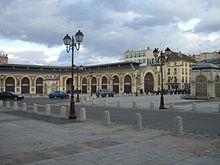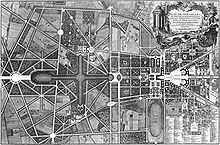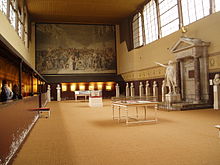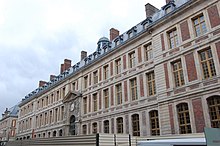Versailles, Yvelines
![]()
This article is about the city of Versailles in France; for other meanings of the same name, see Versailles (disambiguation).
![]() [vɛʀˈsɑːj] is a French city in the Île-de-France region with 85,205 inhabitants (as of 1 January 2018). It is the administrative seat (French: chef-lieu) of the Yvelines department (78) and has been the seat of the Bishopric of Versailles since 1801. An elegant residential town in the catchment area of Paris, it is also a garrison town and one of the most important tourist resorts in the country. It is known worldwide for the Palace of Versailles, built in its largest parts for the "Sun King" Louis XIV in the 17th century, and the 1919 Versailles Peace Treaty signed there.
[vɛʀˈsɑːj] is a French city in the Île-de-France region with 85,205 inhabitants (as of 1 January 2018). It is the administrative seat (French: chef-lieu) of the Yvelines department (78) and has been the seat of the Bishopric of Versailles since 1801. An elegant residential town in the catchment area of Paris, it is also a garrison town and one of the most important tourist resorts in the country. It is known worldwide for the Palace of Versailles, built in its largest parts for the "Sun King" Louis XIV in the 17th century, and the 1919 Versailles Peace Treaty signed there.
The inhabitants are called Versaillais.
Geography
Location
Versailles is located 22 kilometres west of the zero point, which is in the centre of Paris on the forecourt of Notre-Dame. It is nestled in a horseshoe-shaped valley that cuts through a plateau rising from the left bank of the Seine. This valley, closed in the south-east at Viroflay, and opened to the north-west, and extending far beyond Villepreux, reaches its widest extent between Rocquencourt and Satory. Two small hills rise in its centre: the formerly higher Montboron, which was partly removed as the castle was being built, and the hill of Saint-Antoine.
The wooded valley slopes still form a green crown around Versailles with the Bois des Fonds des Maréchaux and the Bois des Fausses Reposes to the north, the forests of Viroflay and Meudon to the east and the forests of Gonards and Satory to the south. In earlier times, they extended to what was later to become the Parade Ground and the present castle grid.
Soil composition
The geological bedrock of the valley consists of Cretaceous limestone. Above it lies a Quaternary clay layer and a mound consisting of sand, on which the castle was built. From the watershed located on Montboron, one of the two streams called Ru flows to the south along the foot of the valley slope (ru de Marival), while the other used to spread out to the west of the castle, forming - due to the impermeable soil - a marshy area with several pools. The most important water bodies were the Étang de Clagny (pond of Clagny), situated to the north near the now disappeared village of the same name, and a waterhole in the area of the second kitchen garden, which still exists today. To the west of the present Swiss Lake was another pond with the evocative name of Étang puant (stinking pond). The final draining of these marshes did not take place until the period between the end of the 17th and the middle of the 18th century.
Climate
The unfavourable nature of the terrain is complemented by the winds blowing almost constantly from the Atlantic, which can penetrate the valley, which is wide open to the west, and cause the temperature in Versailles to be 3 °C lower than in Paris on an annual average.
Neighborhood
Versailles has eight quarters (quartiers). The palace and cathedral are located in the oldest quarter, Notre-Dame. The Saint-Louis quarter borders on Notre-Dame in the direction of Paris. The other quartiers are Chantiers, Montreuil, Porchefontaine, Clagny-Glatigny, Bernard de Jussieu and Satory.
Since it is a town planned in the Baroque period, the street network is straight and symmetrical.
History
The origin of the name is not clear. Occasionally the unsubstantiated assumption is made that it was derived in the 11th century from the Latin versare (to turn, to turn over), and refers to ploughed (turned over) earth.
The fact that Versailles was founded much later than other towns in the area, which were already inhabited in the Gallo-Roman period, could be explained by the above-mentioned unfavourable geographical and climatic conditions. In any case, throughout the Middle Ages, Versailles remained a small, insignificant collection of probably rather poor houses. In the 16th century, Versailles developed into a small market town thanks to its location at the crossroads of three roads.
In the Ancien Régime
Under King Louis XIV, Versailles gradually developed into the centre of power in France. At the beginning of his reign, however, the monarch only stayed in Versailles for short periods at a time. It was not until 1682 that Louis XIV declared Versailles to be the permanent seat of government and court. The extension of the hunting lodge and the park of his father Louis XIII began in 1661 and lasted for several decades. The palace was ultimately intended to visualize the absolutist claim to rule and order. To the east of the castle complex, the king had a new town built. Since then, the city has been structured by three avenues. They run radially towards the square in front of the palace, the Place d'Armes. The street layout copies the goose-foot shape (patte d'oie) that has been common since the Renaissance. This pattern was later applied to the construction of the city of Washington. Despite the size and several extensions made to the palace, not all courtly officeholders were able to occupy an apartment in the complex. Many nobles therefore moved to the city of Versailles, where they either lived for rent or had new palaces' built. In order to counteract the high rents in the city, Louis XIV issued a decree in 1671 exempting nobles in Versailles from land tax and prohibiting mortgages on their residences.
Nevertheless, many high officials remained heavily in debt because of their city apartment. Lower courtiers were often housed in the Grand Commun, an outbuilding near the palace. The cramped living conditions there regularly led to conflicts. On the ground floor were the court kitchens and rooms for the servants of the king and queen. The four floors above were the quarters of the lower courtiers and their servants. The Grand Commun housed both large apartment units with several private rooms and apartments where officials shared antechambers and common rooms. Many courtiers did not settle permanently at Versailles. Their service at court was often limited to a few days a week or a few weeks a year. They therefore continued to live mainly in Paris and its immediate surroundings. In Versailles, they often only needed rented accommodation, from which the innkeepers in particular profited. At the beginning of Louis XIV's reign, the police commissioner of Versailles knew of only about 50 lodgings with furnished rooms, but by 1724 there were already over 400. For the city's inhabitants, renting out living quarters became an important sideline. Furthermore, over 150 inns were built in Versailles.
The street fan became the basic framework of the city of Versailles, around which a regular street grid with representative city squares was laid out. Aristocratic palaces, dwellings for court servants, churches and markets were built in a regular architectural pattern.
The first balloon flight with passengers took place on 19 September 1783. A mutton, a rooster and a duck survived the twelve-minute ride on the Montgolfière.
In the French Revolution
Versailles played an important role in the early stages of the French Revolution. The French King Louis XVI convened the Estates-General in the city to obtain new taxes in the face of a national bankruptcy. The assembly met on 5 May 1789 in the Hôtel des Menus Plaisirs. This building had been constructed around the middle of the 18th century. It was normally used to store theatre scenery, furniture and other paraphernalia needed for courtly festivities at the château. Unlike the château, the Hôtel des Menus Plaisirs had rooms large enough to accommodate the 1200 representatives of the estates. These were joined by spectators. It was in this meeting room that the third estate declared itself the National Assembly on 17 June 1789. However, after the King refused to allow the National Assembly into the Hôtel des Menus Plaisirs, it assembled on 20 June 1789 in the nearby Ballhaus, a gymnasium. There the representatives announced that they would not leave until a constitution had been drawn up.
The French Revolution ended Versailles' status as a seat of residence and government that same year: on 5 October 1789, a protest march of Parisian market women reached the Palace of Versailles. The assembled crowd wanted to persuade the king to accept the resolutions of the National Assembly and to make their demand for a better bread supply heard. On the morning of October 6, the demonstrators stormed the palace and ultimately forced the king to move to Paris. On October 12, 1789, the National Assembly also moved its seat from Versailles to Paris. The loss of importance of Versailles was reflected in the number of inhabitants. While in 1789 about 60,000 people still lived in the city, in 1791 there were only 39,000 inhabitants.
19th and 20th century
In 1801 Versailles became the seat of the new bishopric of the same name.
On 1 July 1815, a battle took place in Versailles as part of the wars of liberation between the Prussians and the French.
On 18 January 1871, the Prussian King Wilhelm I had himself proclaimed German Emperor in Versailles. After the First World War, the Peace Treaty of Versailles was signed there.
The great storm of 26 December 1999 devastated the park, whereupon an extensive programme was launched to restore the original planting in its 17th century arrangement.

View over the Potager du roi (royal vegetable garden) to the cathedral Saint-Louis

The market place in the Notre-Dame district

Versailles in the year 1746. On the left the palace park, in the right quarter the city

Saint-Louis Cathedral, facade

Interior view of the ballroom

The Grand Commun

Hôtel des Menus Plaisirs , meeting place of the Estates General

View over the castle of Versailles to the city
Search within the encyclopedia